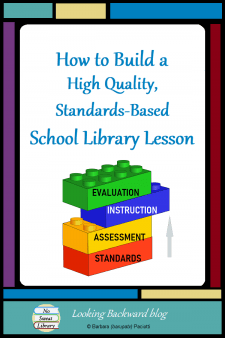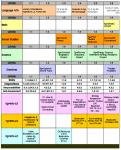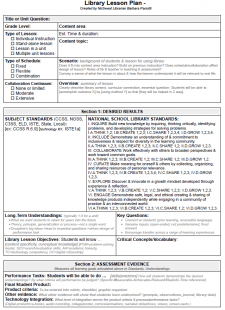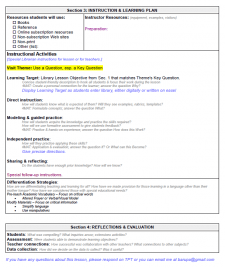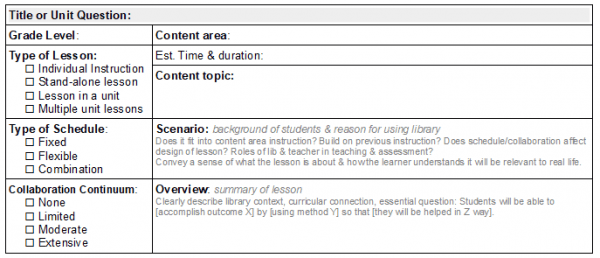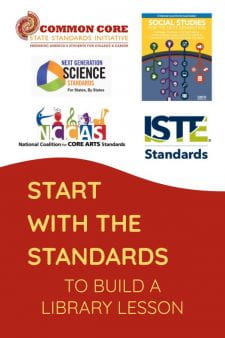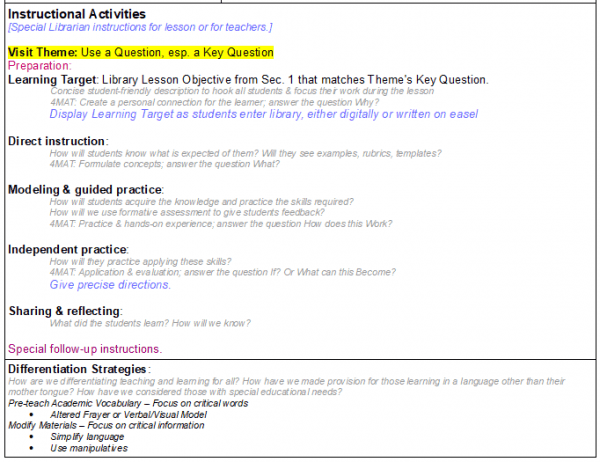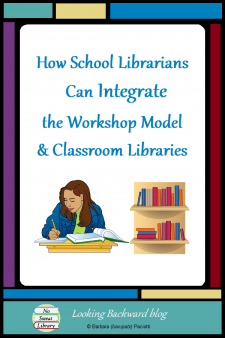 It’s not unusual to see a School Librarian post something like this on my listservs:
It’s not unusual to see a School Librarian post something like this on my listservs:
The English Language Arts department adopted a reading & writing workshop model and classroom libraries. Students choose books in their classrooms and read for 10-minutes at the start of class, so teachers no longer bring them to the library. Our library circulation has plummeted and I don’t think students have the time and freedom they previously had for free reading.
Friends, this is why our library program MUST be more than just books and reading! If we focus only on promoting reading and checking out books, we will suffer when classroom libraries and reading workshop programs are implemented. Our school library must be a multi-faceted learning space, not just a book repository.
I’m a School Librarian who has gone through this experience, and I can tell you that, because I built strong curricular relationships with ELA teachers, I wasn’t adversely affected when our district adopted such a program. Well, we did follow the “rules” for the first semester, but teachers were very unhappy with our reading results, so the following semester we reverted to our already-successful regular recurring ELA library visits with sustained silent reading. Yes, because of our long record of DEAR/SSR, we were able to see the shortcomings of the new model.
PITFALLS OF POOR WORKSHOP IMPLEMENTATION
- 10-minute reading doesn’t allow story immersion
Students need 2 or 3 chapters to really get into a story, and that takes a lot longer than 10 minutes. Teachers found that students weren’t continuing to read a book they’d chosen the day before, but would look for a new one. Limiting their browse time didn’t solve the problem and students just grabbed any book off the shelf, read for the allotted time period, then put the book back and grabbed a new one the next day. Students weren’t really “reading” nor finishing books; they were just fulfilling a “requirement.”
linebreak - 10-minute reading doesn’t foster comprehension
Try it yourself. Pick up a new book and read for 10 minutes, then mark your place and put it away. The next day, pick up the same book and begin reading where you left off—don’t reread—for 10 minutes. Do the same thing for a third day, and when you put the book down, write a short summary of the story. The fourth day, start a brand new book at the beginning and read for 25-30 minutes, then write a short summary of the new story. Compare the two summaries: you’ll shake your head at the shallow understanding those short reading periods gave you and how much more you got out of the longer sustained reading session. You’ll also want to continue reading that second book!
linebreak - 10-minute reading doesn’t build reading endurance
When we reverted back to our regular library visits with DEAR Time, kids would look at the clock after 8 or 9 minutes to see if the “10 minutes” they’d gotten used to was over—and then they’d get restless and disruptive. Even upper grades who had enjoyed extended reading in prior years did this. We cajoled and stuck with it–providing the same long DEAR Time in classrooms in the off weeks–and eventually students settled into reading for 25-30 minutes.
So ended our experiment with daily reading as a “bell-ringer” activity. In all fairness, the workshop model is intended to provide lengthier reading times, but all too often teachers make “reading workshop” into chopped-up text analysis instead of free reading and an ending summation activity.
DON’T FIGHT CLASSROOM LIBRARIES – SUPPORT THEM
I rarely purchase more than 2 hardback copies of any book, even if popular, because extra copies sit on the shelf after the first burst of interest and are weeded for non-circulation within a couple years. I’m happy to have teachers build classroom libraries with several paperback copies of best sellers. By the time popularity wanes, the books are worn out and latecomers are satisfied by the 2 library copies.
Classroom libraries mean fewer intermittent book checkouts, but those aren’t a huge contributor to circulation. With nascent classroom libraries, teachers limited students to 1 book at a time from their shelves, and with the workshop model’s increased reading, I decided to increase book checkout limits from 2/student to 3/student and, by the end of the school year, to 4/student. Students also read during downtime in other subject areas, so by having an extra book from the school library, they can start a new story instead of waiting for ELA class or bi-weekly library visit. Continued reading increased our circulation beyond what was expected from just increasing checkout limits!
Classroom libraries did produce 2 problems for ELA teachers: lack of shelf space for books and lack of funds to keep purchasing new books. Because they were so supportive of the library program, I wanted to help:
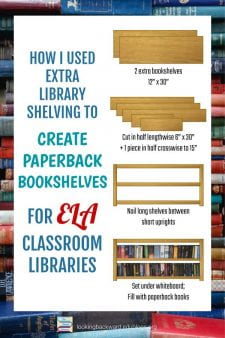 For the library’s 5-foot high bookcases I use 3 shelves for books and the bottom shelf to display new or topical books. Since each bookcase came with 5 shelves, I had more than 100 extra solid oak shelves stacked up.
For the library’s 5-foot high bookcases I use 3 shelves for books and the bottom shelf to display new or topical books. Since each bookcase came with 5 shelves, I had more than 100 extra solid oak shelves stacked up.
linebreak
Deciding to use these extra shelves, I designed a 6” deep, 2-shelf bookcase to fit under whiteboards in ELA classrooms. I had a high school construction class build 4 of these for each ELA teacher. You can imagine their surprise when I gave each teacher 20 feet of additional paperback shelving that didn’t eat into their classroom space!
linebreak- I’d been running a school store during lunch in the cafeteria for a couple years. Priced from 25¢ to $2, students gobbled up these fun & flashy school supplies, and the income purchased more supplies. Still, I had accumulated some significant profits, so I decided to donate $385 of school store profits to the ELA department to purchase new books for their classroom libraries.
linebreak
If ELA teachers were delighted with the bookshelves, they were over-the-moon about the money! They met at our local brand-name bookstore that very weekend and chose dozens of new books–substantially discounted, thanks to a supportive store manager. They praised students for helping to get those books by supporting the school store, and my business boomed even more during ensuing weeks. At the end of the school year I donated another $160 to ELA teachers.
The point here is, instead of complaining about classroom libraries, I found a way to solve the problems my ELA colleagues were having with this curricular change. Instead of a drop in circulation, ELA teachers were even more consistent about bringing students to the library and my circulation soared!
INTEGRATED THEMATIC LIBRARY “WORKSHOP” LESSONS
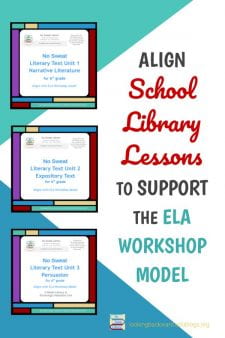 In its simplest form, the workshop model has 4 parts: opening, mini-lesson, work time, and debriefing. This coordinates with the 4 instructional steps of my Library Lesson Planner: direct instruction, modeling & guided practice, independent practice, and sharing & reflecting, so I configure our library visits as Reader Writer Workshops:
In its simplest form, the workshop model has 4 parts: opening, mini-lesson, work time, and debriefing. This coordinates with the 4 instructional steps of my Library Lesson Planner: direct instruction, modeling & guided practice, independent practice, and sharing & reflecting, so I configure our library visits as Reader Writer Workshops:
• Warm-up – I share Learning Targets and allow for the return of books.
• Mini-Lesson – Direct Instruction and Modeling & guided practice to the whole class.
• Workshop is Independent practice. Usually we have Reader Workshop where students browse for new books and have DEAR Time free reading. Sometimes the lesson is Writer Workshop where students complete an activity.
• Sharing & reflecting – The last several minutes of the period is our by-table book checkout and I can talk to each student about the books they’ve chosen.
With the first Library Orientation visit, 6g ELA teachers liked my adoption of the Workshop model, but I knew I could do more. I studied the new scope & sequence, and I could see opportunities for Library Lessons that would provide a more enriching experience covering the entire class period.
Teachers and I collaborated to customize Library Lessons with Literary Text Unit Themes and integrate their classroom learning activities into a full-period Library Lesson visit. The new Library Lessons are spread out over the entire unit, yet we still allow plenty of time for book browsing and silent reading. Because we collaborated, English Language Arts is intricately woven into every-other-week library visits, and the content and pacing of curriculum is not just preserved, but enhanced.
I’ve adapted 6th grade Literary Text Units for use by any middle school librarian. Units for Narrative text, Expository text, and Persuasion units are available from No Sweat Library, my TeachersPayTeachers store. A poetry unit is under construction.
MAKE EVERY LIBRARY VISIT IRREPLACEABLE
I clarify that my school library program wasn’t negatively impacted by the workshop model and classroom libraries for 3 reasons:
- We’d already established regularly scheduled library visits with silent reading every other week for all ELA classes.
- I’d already created short Library Lessons for some visits that supported classroom learning.
- The strong relationship between School Librarian and English Language Arts teachers prompted collaboration to overcome the deficiencies of the workshop curricular plan.
The School Library can’t just be about reading books. School Librarians need to rigorously contribute to student learning by fully integrating Library Lessons into all subject curricula. Otherwise, we can’t lament a lack of appreciation for the library when curriculum changes affect our circulation.
![]()


